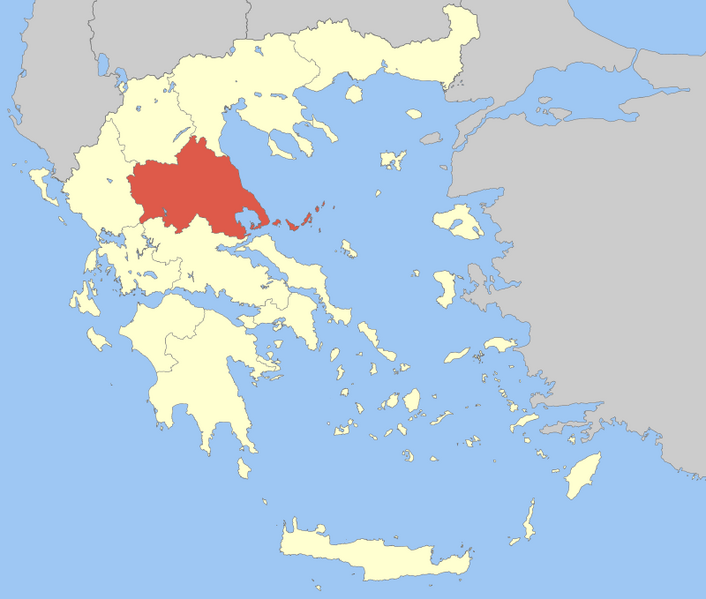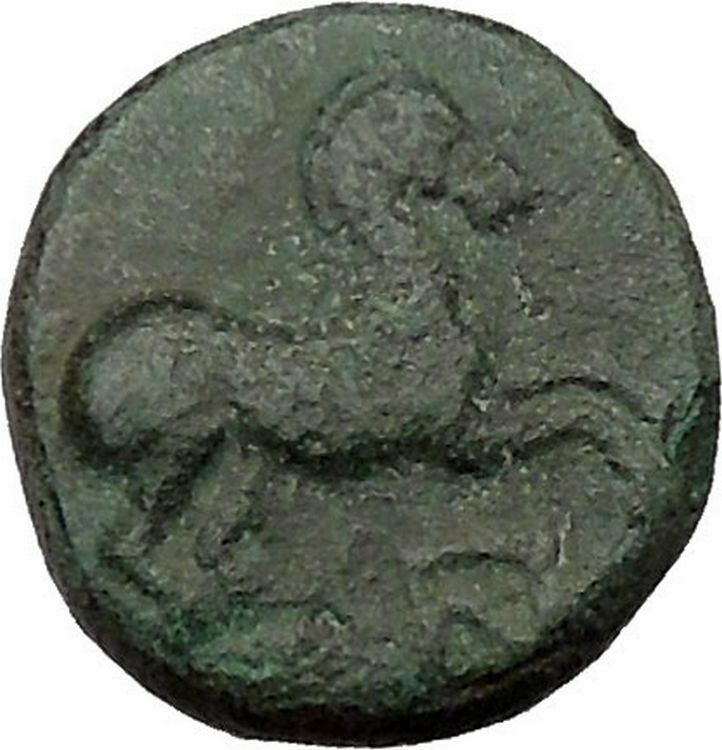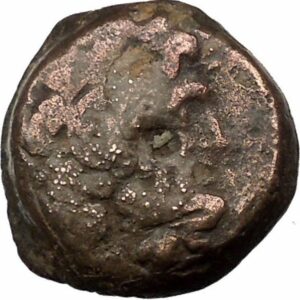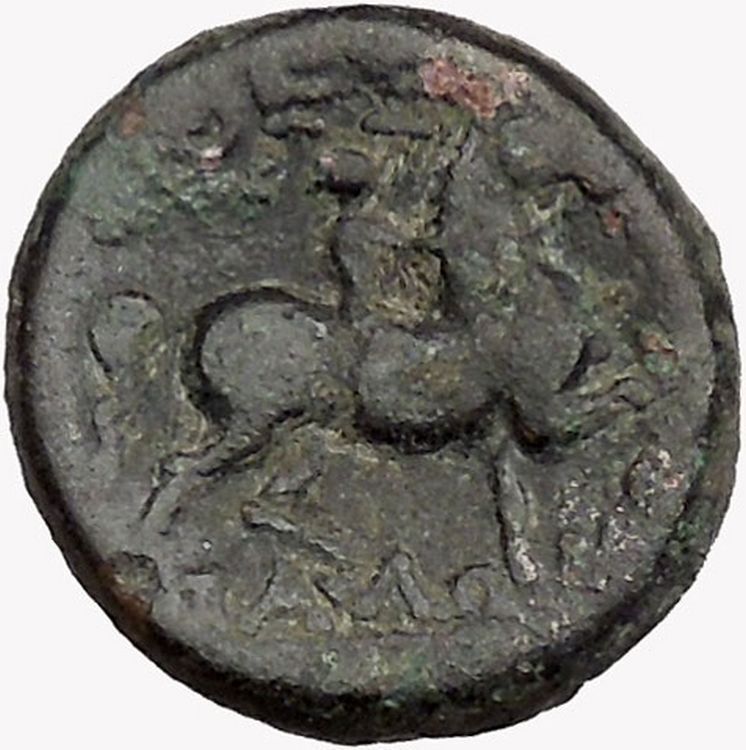|
Item: i36437


Authentic
Ancient Coin of:
Greek city of Pelinna in
Thessaly
Bronze 18mm (5.07 grams) Struck 306-197 B.C.
Reference: Sear 2167; Rogers 433; SNG Copenhagen 191
Veiled head of Mantho right.
Horseman riding right, holding couched lance;
monogram below.
Pelinna (Latin:
Pelinnseum) was an
ancient Greek
city
with a
celebrated
temple
of
Zeus
Pelinnaeus,
in Estiaeotis,
ancient Thessaly
.
Pelinna was situated between
Tricca
and
Pharcadon
, near
modern Palaiogardiki (Trikala
prefecture). The city gained particular
prominence in the fourth century BC through its
alliance with
Philip II of Macedon
.
Among other archaeological evidence of the religious
significance of Pelinna are two
Orphic
gold tablets
(lamellae)
found in 1985 on the site of Petroporos, dating to
the late 4th century BC
You
are bidding on the exact item pictured, provided
with a Certificate of Authenticity and Lifetime
Guarantee of Authenticity.
Thessaly is a traditional
geographical region
and an
administrative region
of
Greece
, comprising
most of the
ancient region
of
the same name. Before the
Greek Dark Ages
,
Thessaly was known as Aeolia, and appears
thus in
Homer
‘s
Odyssey
.
Thessaly became part of the
modern Greek state
in 1881, after four and a half centuries of
Ottoman
rule. Since
1987 it has formed one of the country’s 13
regions
and is
further (since the
Kallikratis reform
of 2010) sub-divided into 5
regional units
and
25
municipalities
. The
capital of the region is
Larissa
. Thessaly
lies in central Greece and borders the regions of
Macedonia
on the
north,
Epirus
on the west,
Central Greece
on
the south and the
Aegean Sea
on the
east. The Thessaly region also includes the
Sporades
islands.
History
Ancient history
Thessaly was home to an extensive
Neolithic
culture
around
2500 BC
.
Mycenaean
settlements have also been discovered, for example
at the sites of
Iolcos
,
Dimini
and
Sesklo
(near
Volos
). In Archaic
and
Classical
times,
the lowlands of Thessaly became the home of baronial
families, such as the
Aleuadae
of
Larissa
or the
Scopads of Crannon. In the 4th century BC
Jason of Pherae
transformed the region into a significant military
power, recalling the glory of Early Archaic times.
Shortly after
Philip II of Macedon
was appointed Archon of Thessaly, and
Thessaly was thereafter associated with the
Macedonian Kingdom for the next centuries. Thessaly
later became part of the
Roman Empire
as
part of the province of
Macedonia
. The
region of Thessaly in the 7th century, experienced
an influx of
Slavic
warlords,
Perboundos
the
Slavic king who established permanent settlement in
Macedonia
also
included Thessaly, as part of his Slavic realm and
region. He named the region “Belzetia” and appointed
a lord to govern and peacefully maintain order. The
Slavic
Belegezites
tribes,
under king Perboundos began building settlements and
agricultural farms known as
subsistance communal farms
.
The lord of Thessaly
Akamir
was at war
with the
Roman Empire
, and
by 700 AD a fortress was fully built. The Slavs of
Macedonia had included Thessaly as part of
Sklavinia
, the
Battle of Larissa
occurred in 780 AD.
Medieval and Ottoman Thessaly
Thessaly remained part of the East Roman
“Byzantine” Empire after the collapse of Roman power
in the west, and subsequently suffered many
invasions, such as by the Slavic tribe of the
Belegezites
in the
7th century AD. Following the campaigns of the
Byzantine general
Staurakios
in
782-783, the Byzantine Empire recovered Thessaly
(then known as
Hellas
), taking
many Slavs as prisoners.[4]
In 977 it was raided by the Bulgarians.
Dissatisfaction about the taxation policy led in
1066 the Aromanian and Bulgarian population of
Thessaly to revolt against the Byzantine Empire
under the leadership of a local lord,
Nikoulitzas Delphinas
.[5]
The revolt, which began in
Larissa
, was soon
expanded in
Trikala
and later
northwards to the Byzantine-Bulgarian border. In
1199-1201 another unsuccessful revolt was led by
Manuel Kamytzes
,
son-in-law of Byzantine emperor
Alexios III Angelos
.[6]
In 1204 it was assigned to
Boniface of Montferrat
and in 1225 to
Theodore Komnenos Doukas
,
despot of
Epirus
. From 1271
to 1318 it was an independent despotate that
extended to
Acarnania
and
Aetolia
, run by
John I Doukas
. In
1309 settled there the
Almogavars
or
Catalan Company
of
the East (Societas Catalanorum Magna), which in
1310, after lifting the siege of Thessalonica,
withdrew as mercenaries in the pay of the
sebastokrator
John II Doukas
, and
took over the country organized in a democracy. From
there they departed to the
Duchy of Athens
,
called by the duke
Walter I
. In 1318,
with the extinction of the
Angelid
dynasty,
the Almogavars occupied Siderokastron and southern
Thessaly (1319) and formed the
duchy of Neopatria
.

One of the flags used in Thessaly during
the
Greek War of
Independence
(designed by
Anthimos Gazis
).
In 1348, it was invaded and occupied by the
Serbs
under
Preljub
. After the
latter’s death in 1356, the region was conquered by
Nikephoros Orsini
,
and after his death three years later, it was taken
over by the self-proclaimed Serbian emperor
Simeon Uroš
.
Simeon’s son
John Uroš
succeeded
in 1370 but abdicated in 1373, and Thessaly was
administered by the Greek Angeloi-Philanthropenoi
clan until the
Ottoman
conquest c.
1393. Ottoman control was disputed by the Byzantines
until the 1420s, when it was consolidated by
Turahan Bey
, who
settled
Turkomans
in the
province and founded the town of
Tyrnavos
.
In 1821, parts of Thessaly and
Magnesia
participated in the initial uprisings in the
Greek War of Independence
,
but these revolts were swiftly crushed. Thessaly
became part of the modern Greek state in 1881, after
the
Treaty of Berlin
.
Geography

Volos
view from
Pelion
mountain.
Thessaly occupies the east side of the
Pindus
watershed,
extending south of Macedonia to the
Aegean Sea
. The
northern tier of Thessaly is defined by a generally
southwest-northeast spur of the Pindus range that
includes
Mount Olympus
,
close to the Macedonian border. Within that broken
spur of mountains are several basins and river
valleys. The easternmost extremity of the spur
extends southeastward from Mt. Olympus along the
Aegean coast, terminating in the
Magnesia
Peninsula
that envelops the
Pagasetic Gulf
(also called the Gulf of Volos), and forms an inlet
of the Aegean Sea. Thessaly’s major river, the
Pineios
, flows
eastward from the central Pindus Range just south of
the spur, emptying into the
Thermaic Gulf
.
The
Trikala
and
Larissa
lowlands
form a central plain which is surrounded by ring of
mountains. It has a distinct summer and winter
season, with summer rains augmenting the fertility
of the plains. This has led to Thessaly occasionally
being called the “breadbasket of Greece”.
The region is well delineated by topographical
boundaries. The
Chasia
and
Kamvounia
mountains
lie to the north, the Mt. Olympus massif to the
northeast. To the west lies the Pindus mountain
range, to the southeast the coastal mountains of
Óssa
and
Pelion
.
Several tributaries of the Pineios flow through
the region.
Demographics
According to the census conducted by ESYE in
2011, the population of the region of Thessaly is
732,762 and represents 6.8% of the total population
of the country.
It has noted a 2.8% decrease in the population
since 2001 and remains the third largest region in
the country population-wise.
The population break-down is 44% urban, 40%
agrarian and 16% semi-urban with the agrarian
population having noted a decline which has been
paralleled with an increase in the semi-urban.
The metropolitan area of Larissa, the capital of
Thessaly, is home to more than 230,000 people,
making it the biggest city of the region.
Major communities

Litheos river flowing through city of
Trikala
.
Economy
The alluvial soils of the
Pineios
Basin and
its tributaries make Thessaly a vital agricultural
area, particularly for the production of
grain
,
cattle
, and
sheep
.
Modernization of agricultural practices in the
mid-20th century has controlled the chronic flooding
that had restricted agricultural expansion and
diversification in the low-lying plains. Thessaly is
the leading cattle-raising area of
Greece
, and
Vlach
shepherds
shift large flocks of
sheep
and
goats
seasonally
between higher and lower elevations. The last
decades, there is a rise in cultivating dried nuts
such as
almonds
,
pistachios
and
walnuts
especially
in the region of
Almyros
. Rise in
the number of olive oil trees have been also
observed. The nearly landlocked
Gulf of Pagasai
provides a natural harbor at
Volos
for shipping
the agricultural products from the plains just to
the west and chromium from the mountains of
Thessaly.
Transport
There are a number of highways
E75
and the main
railway from
Athens
to
Thessaloniki
(Salonika)
crosses Thessaly. The region is directly linked to
the rest of Europe through
International Airport of
Central Greece
located in
Nea Anchialos
in a
small distance from
Volos
and
Larisa
. Until today
charter
flights
links the region and brings tourists to the wider
area, mainly in
Pelion
and
Meteora
. The new
infrastructure includes a brand new terminal ready
to serve 1500 passengers per hour and new airlanes.
Administration
The Thessaly region was established in the 1987
administrative reform. In everyday use, “Thessaly”
is identified with the administrative region,
although the historical region extended south into
Phthiotis
and at
times north into
West Macedonia
as
well.
With the 2010
Kallikratis plan
,
the powers and authority of the region were
redefined and extended. Along with
Central Greece
, it
is supervised by the Decentralized Administration of
Thessaly and Central Greece, based at
Larissa
. The region
is based at
Larissa
and is
divided into five
regional units
(four were pre-Kallikratis
prefectures
),
Karditsa
,
Larissa
,
Magnesia
, the
Sporades
and
Trikala
, which are
further subdivided into 25
municipalities
.
The region’s governor is, since 1 January 2011,
Konstantinos Agorastos
,
who was elected in the
November 2010 local
administration elections
for the
New Democracy
party.
Mythology
In
Homer
‘s epic, the
Odyssey
,
Odysseus
visits the
kingdom of Aeolus, and this is the old name for
Thessaly.
The Plain of Thessaly, which lies between
Mount Oeta
/Othrys
and
Mount Olympus
, is
the site of the
battle
between the
Titans
and the
Olympians
.
According to legend,
Jason
and the
Argonauts
launched
their search for the Golden Fleece from the Magnesia
Peninsula.
|












